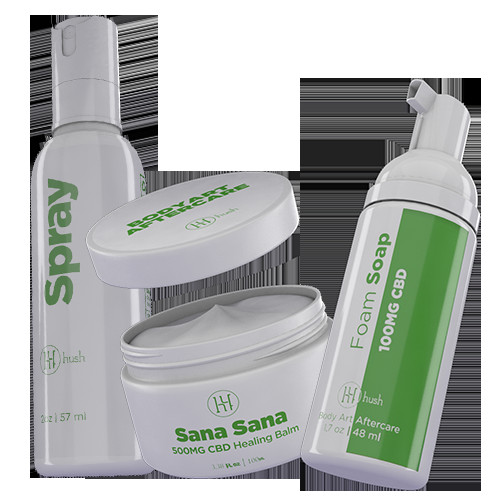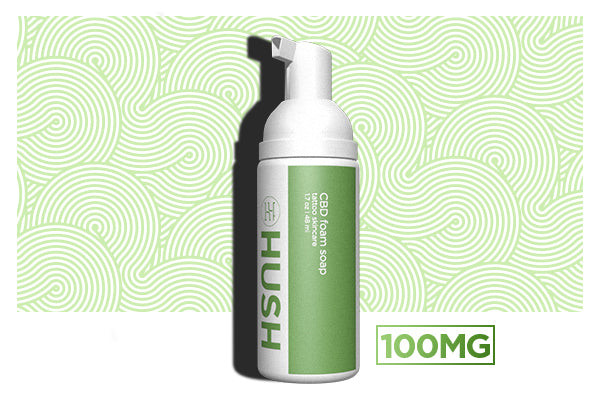Does A Tattoo Hurt Afterwards? Yes, a new tattoo can feel sore, like a sunburn or a bruise, but proper aftercare can minimize discomfort. At tattooat.com, we provide expert guidance on tattoo aftercare to ensure your body art heals beautifully and remains vibrant. Understanding the healing process and following our aftercare tips will help you manage any pain and protect your investment.
1. Understanding Post-Tattoo Pain
The sensation after getting a tattoo varies from person to person, depending on factors like pain tolerance, tattoo placement, size, and the artist’s technique. However, some level of discomfort is normal as your skin begins to heal.
What to Expect Immediately After
Immediately after getting a tattoo, it’s common to experience:
- Redness: The area around the tattoo will likely be red and inflamed.
- Tenderness: The skin will feel sensitive to the touch.
- Aching: Similar to a sunburn, you may experience a dull ache.
The First Few Days
During the first few days, the pain may persist and evolve:
- Increased Sensitivity: The tattooed area may feel more sensitive.
- Swelling: Mild swelling is normal.
- Warmth: The area may feel warm to the touch due to inflammation.
 New tattoo on arm with clear bandage
New tattoo on arm with clear bandage
Alt text: Freshly inked arm tattoo covered with a transparent bandage, showcasing initial aftercare.
2. Tattoo Aftercare: Minimizing the Pain
Proper aftercare is essential not only for preventing infection and ensuring the longevity of your tattoo but also for minimizing pain and discomfort during the healing process.
Gentle Cleaning
Keep the tattooed area clean to prevent infection and promote healing:
- Use Mild Soap: Wash the tattoo gently with a fragrance-free, antibacterial soap.
- Lukewarm Water: Avoid hot water, which can irritate the skin.
- Pat Dry: Use a clean, soft towel to pat the area dry, rather than rubbing it.
Moisturizing
Keeping the skin moisturized is crucial for reducing itching and promoting healing:
- Apply Thin Layer: Apply a thin layer of tattoo-specific ointment or a fragrance-free moisturizer.
- Avoid Over-Moisturizing: Too much moisture can trap bacteria.
- Use Recommended Products: Follow your tattoo artist’s recommendations for the best products.
Protecting Your Tattoo
Protecting your tattoo from external irritants is key:
- Loose Clothing: Wear loose-fitting clothing to avoid friction.
- Sun Protection: Avoid direct sunlight and use sunscreen (SPF 30 or higher) once the tattoo is fully healed.
- Avoid Picking: Resist the urge to scratch or pick at scabs.
3. Understanding the Tattoo Healing Stages
Knowing what to expect during each stage of the healing process can help you manage pain and ensure proper care.
Stage 1: The First Week
- Symptoms: Redness, tenderness, swelling, oozing.
- Care: Gentle cleaning, moisturizing, and protection.
Stage 2: Weeks 2-3
- Symptoms: Itching, peeling, scabbing.
- Care: Continue cleaning and moisturizing, avoid scratching.
Stage 3: Weeks 4-6
- Symptoms: Skin may appear dry and dull.
- Care: Regular moisturizing, continued sun protection.
4. What Can Make Post-Tattoo Pain Worse?
Certain activities and conditions can exacerbate post-tattoo pain and hinder the healing process.
Irritants to Avoid
- Tight Clothing: Restricts airflow and causes friction.
- Harsh Soaps: Can dry out and irritate the skin.
- Sun Exposure: Can cause blistering and fading.
- Scratching: Leads to infection and scarring.
Activities to Avoid
- Swimming: Exposes the tattoo to bacteria in water.
- Intense Exercise: Excessive sweating can irritate the tattoo.
- Soaking in Water: Baths and hot tubs can increase the risk of infection.
The Dry Healing Myth
Dry healing, or avoiding moisturizers, can lead to excessive dryness, cracking, and increased pain. According to research from Portland State University’s Art Department, in July 2025, using a tattoo-specific moisturizer can help prevent these issues.
5. Effective Products for Pain Relief
Several over-the-counter products can help alleviate post-tattoo pain and promote healing.
Soothing Products
- Tattoo Balms: Specially formulated to soothe and moisturize tattooed skin.
- CBD-Infused Products: Known for their anti-inflammatory and pain-relieving properties.
- Anesthetic Gels: Topical anesthetics can provide temporary relief from pain and itching. HUSH’s pain-relieving gels provide additional comfort. You can also use topical anesthetic spray on new tattoos to soothe excessive discomfort.
Cleansing Products
- Antibacterial Soaps: Gentle, fragrance-free options to keep the area clean.
- Foaming Soaps: Easy to apply and rinse off, minimizing irritation.
 CBD Foaming Soap
CBD Foaming Soap
Alt text: Gentle CBD foam soap for tattoo aftercare
6. Lifestyle Adjustments for Comfort
Making certain lifestyle adjustments can significantly reduce post-tattoo pain and promote faster healing.
Diet and Hydration
- Stay Hydrated: Drink plenty of water to keep your skin hydrated.
- Eat Nutritious Foods: A balanced diet supports the healing process.
Rest and Recovery
- Get Enough Sleep: Adequate rest helps your body heal.
- Avoid Stress: Stress can weaken your immune system and slow healing.
Clothing Choices
- Loose Fabrics: Opt for breathable, loose-fitting clothing.
- Avoid Irritating Materials: Steer clear of wool or synthetic fabrics that can cause friction.
7. Recognizing Signs of Infection
While some pain and discomfort are normal, it’s important to recognize the signs of a potential infection.
Common Infection Symptoms
- Excessive Redness: Spreading redness around the tattoo.
- Increased Pain: Pain that worsens over time.
- Swelling: Significant swelling accompanied by heat.
- Pus: Yellow or green discharge.
- Fever or Chills: Systemic symptoms indicating infection.
When to Seek Medical Attention
If you experience any of the above symptoms, seek medical attention immediately. According to the American Academy of Dermatology, early treatment can prevent serious complications.
8. Advice from Tattoo Artists
Experienced tattoo artists offer valuable insights into managing post-tattoo pain and ensuring proper healing.
Following Instructions
- Listen to Your Artist: Follow their specific aftercare instructions carefully.
Product Recommendations
- Use Recommended Products: Artists often recommend specific cleansers, moisturizers, and balms.
Knowing When to Call
- Don’t Hesitate to Ask: If you have any concerns or questions, contact your artist.
HUSH anesthetic tattoo numbing and aftercare products provide you with quality, affordable tattoo skincare products. Whether you are the tattoo artist or the client receiving the ink (or both), our products serve a purpose in your tattoo experience that helps you focus on the art instead of the ouch.
9. Debunking Common Tattoo Pain Myths
Many myths surround tattoo pain and aftercare. Let’s debunk some of the most common ones.
Myth 1: Tattoos Don’t Hurt After Getting Them
- Reality: Some level of pain and discomfort is normal as the skin heals.
Myth 2: Dry Healing Is the Best Method
- Reality: Moisturizing is essential to prevent dryness and cracking.
Myth 3: All Tattoo Aftercare Products Are the Same
- Reality: Tattoo-specific products are formulated to be gentle and effective.
Myth 4: You Can’t Exercise After Getting a Tattoo
- Reality: Light exercise is okay, but avoid intense workouts that cause excessive sweating and movement.
10. Frequently Asked Questions (FAQs) About Post-Tattoo Pain
Here are some frequently asked questions to help you navigate the post-tattoo healing process with confidence.
1. How long does the pain last after getting a tattoo?
The initial pain typically lasts for a few days to a week. Tenderness and sensitivity may persist for several weeks.
2. Can I take pain relievers for tattoo pain?
Yes, over-the-counter pain relievers like ibuprofen or acetaminophen can help manage pain.
3. Is it normal for my tattoo to itch?
Yes, itching is a common symptom during the healing process. Avoid scratching to prevent damage.
4. How often should I moisturize my tattoo?
Moisturize your tattoo 2-3 times a day, or as needed, to keep the skin hydrated.
5. Can I use any lotion on my new tattoo?
No, use a fragrance-free, hypoallergenic lotion or a tattoo-specific balm.
6. What should I do if my tattoo is oozing?
A small amount of clear fluid is normal. Excessive oozing or pus may indicate an infection.
7. Can I wear tight clothing over my tattoo?
No, wear loose-fitting clothing to avoid friction and irritation.
8. How soon can I go swimming after getting a tattoo?
Avoid swimming for at least 2-3 weeks, or until the tattoo is fully healed.
9. Can I expose my tattoo to the sun?
Avoid direct sunlight during the healing process. Once healed, use sunscreen with SPF 30 or higher.
10. When should I contact my tattoo artist or doctor?
Contact them if you experience signs of infection or have any concerns about the healing process.
Address: 1825 SW Broadway, Portland, OR 97201, United States.
Phone: +1 (503) 725-3000.
Website: tattooat.com.
Ready to explore stunning tattoo designs, find talented artists, and dive into comprehensive tattoo knowledge? Visit tattooat.com today and start your tattoo journey with confidence. Discover inspiration, connect with professionals, and learn everything you need to know about tattoos in the USA!
